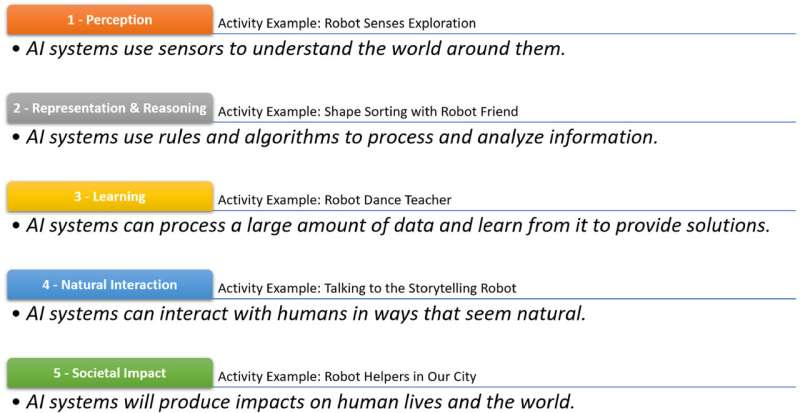This article has been reviewed according to Science X's editorial process and policies. Editors have highlighted the following attributes while ensuring the content's credibility:
fact-checked
proofread
Study redevelops framework for teaching artificial intelligence and robotics

Just like computers, the Internet, and smartphones have become commonplace in our daily lives, artificial intelligence and robotics (AIR) are the next technologies in line to drastically change how we interact with the world and among ourselves. Various AI-driven applications, such as Siri, Google Assistant, and ChatGPT, are already in widespread use, and both industrial- and consumer-grade robots are becoming increasingly capable and accessible.
In our modern societies, where people rely increasingly on AIR systems to perform tasks, it's essential to prepare children and teenagers to understand and use these tools effectively. To this end, the AI4K12 initiative was developed, comprising a set of guidelines for teaching AI within K-12 education. Notably, AI4K12 outlines "five big ideas of AI" as foundational concepts or key principles that are deemed essential to grasp AI. However, these big ideas are too complex for children younger than six years old.
Against this backdrop, a research team comprising Dr. Weipeng Yang, an Assistant Professor at the Education University of Hong Kong and Jiahong Su from the University of Hong Kong decided to revise AI4K12's framework and identify five big ideas of AI that are better suited for young children, especially preschoolers.
Their study was published online in the journal ECNU Review of Education on December 10, 2023. Notably, these authors had published another study on April 19, 2023, in which they proposed a theoretical framework to guide the use of AI tools, such as ChatGPT, in education.
The first big idea addresses the concept of AIR perception. Children should understand that robots and computers can use a variety of sensors to perceive their surroundings and make decisions accordingly. One way to teach this concept is through demonstration, using either a simple robot with an exploratory task or by having children role-play themselves as wandering robots with limited or altered sensing capabilities.
The second big idea introduces the concepts of AI representation and reasoning. Dr. Yang explains, "AI systems work on algorithms and use codes to interpret information, which differs from our understanding and thought process. Young children need to understand that AI's process of perceiving the world is different from that of humans. They should acknowledge the unique features of AI that complement human qualities."
A hands-on activity like shape-sorting alongside a robotic friend may properly illustrate this big idea in a way children can comprehend.
The third big idea is related to AI learning. Children should understand that AIR systems can process very large amounts of data to arrive at their proposed results or solutions. Moreover, they should know that AI can learn from new information to help humans solve tasks.
The fourth big idea revolves around the concept of natural interactions between AIR and humans. Children should understand that AIR systems are developed by humans and lack consciousness or self-awareness.
Finally, the fifth big idea addresses the societal impact of AIR. Children must be taught that AI will have (or have already had) a profound impact on human lives and the world. "Educating children on AI right from the preschool will ensure effective application of AI tools by students," says Dr. Yang.
The article also proposes several ways to engage young children in learning about the five big ideas of AI through the use of robotics. Specifically, the researchers emphasize the importance of interactive and memorable experiences, especially through acts of play and other hands-on opportunities to interact with AIR systems.
"Our five big ideas of AI framework redeveloped from AI4K12 will help children better understand AI and its importance in the rapidly developing digital society," concludes Dr. Yang.
Hopefully, children of all ages will soon be able to experience and understand AI in a healthy and responsible manner, leading to new applications and learning opportunities.
More information: Jiahong Su (苏嘉红) et al, Artificial Intelligence and Robotics for Young Children: Redeveloping the Five Big Ideas Framework, ECNU Review of Education (2023). DOI: 10.1177/20965311231218013
Provided by Cactus Communications





















